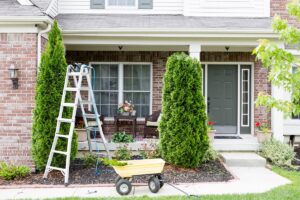The 2025 Hurricane Season is gearing up to be intense. Already, forecasters are predicting 11 named storms with potentially four or more major hurricanes.
The best thing you can do is be prepared for the next devastating storm. That’s why we reached out to Aaron Levy, Director of Individual and Community Preparedness at the Federal Emergency Management Agency (FEMA), to learn how you can prepare your home for this year’s hurricane season.
Are you in the path of the storm?
Florida, the Carolinas, even Texas and Louisiana are well-known to receive the brunt of hurricanes, but you may be surprised to learn hurricanes can happen along any U.S. coast or territory in the Atlantic or Pacific. However, you may be surprised where most hurricane-related damage occurs.
“It’s actually inland flooding that often causes the most damage and the most injuries,” says Aaron, “and unfortunately the highest amount of losses of life.”
Hurricanes can affect areas more than 100 miles inland. During Aaron’s 12-year tenure with FEMA, he has seen hurricane damage in places such as West Virginia, Pennsylvania, and even parts of New England.
“While hurricanes are generally a coastal event, the impacts can be felt very far inland,” says Aaron.
Hurricane season starts on June 1st, and Atlantic hurricane season runs through November 30th. Though there have been deadly hurricanes as early as mid-June and as late as mid- to late-November, most severe storms happen in the middle of the season.
“If you look at the data, we often see the most storms occurring in that late summer, early fall range,” says Aaron.
However, it’s never too early to prepare.
How to prepare for a hurricane

“Homeowners shouldn’t be waiting for the first day of hurricane season to take preparedness actions to make themselves safer and more resilient,” says Aaron.
There are five major steps to preparing your family and your home for hurricane season.
Step 1 – Prepare an emergency supply kit
Start by gathering items inside your home for an emergency supply kit. This kit may include:
- Potable water for those in the household. (“We often say a gallon of potable water per person per day. I recommend about three-days worth of potable water per person in your household.”)
- Non-perishable food and a manual can opener (to open said food).
- Paper cups, plates, towels, and utensils.
- First-aid kit.
- Prescription and non-prescription medication.
- Flashlights.
- Batteries.
- Prescription eyeglasses and contact lenses.
- Feminine supplies and personal hygiene items.
- Baby supplies (formula, diapers, wipe and diaper rash cream) if necessary.
- Pet food and extra water if necessary.
- A whistle to call for help.
- Dusk mask (to filter contaminated air).
- Plastic sheet and duct tape to shelter in place.
- Cell phones with chargers and a backup battery.
- Local maps (in case your phone isn’t working).
- Antibacterial gel and garbage bags (for personal sanitation).
- Wrench or pliers in case you need to turn off your utilities.
- Cash.
- Paper and pencil.
- Fire extinguisher.
“Building an emergency kit can be daunting, especially for a new homeowner who just bought a house,” says Aaron. “The advice I often give is to do it in stages.”
Buy one supply every time one goes to the supermarket, and in a month or two, you’ll have built your kit!
Step 2 – Gather important documents.

Have important medical, insurance, and banking information and documents either digitally or as part of your emergency or evacuation kit.
“I’ve had some experience being deployed for FEMA after a disaster where people walk into shelters or our disaster recovery centers and they don’t have anything,” says Aaron. “If they just had their insurance, medical, and banking information saved on a file safely and securely on their phone, that’s going to help us jumpstart their recovery.”
FEMA offers the Emergency Financial First Aid Kit to help homeowners keep track of their important documents.
Quick reminder: Don’t forget to gather your pets’ information as well!
Step 3 – Make a plan and practice it before hurricane season.
Know the evacuation routes in your area and discuss the details.
Explains Aaron, “Where’s everybody going to meet? Is that grandma’s house? Is that a friend’s house? Are you evacuating to a hotel or a shelter somewhere out of the storm area? You want to start to talk about that plan.”
Also, make sure to make this a family discussion, so everyone’s needs can be met.
“Homeowners need to involve grandma and grandpa and neighbors, especially those who might not have the resources to build that kit and make a plan on their own,” says Aaron. “It’s important to be inclusive.”
You want to have those discussions now to make sure that you’re taking steps to make yourself more resilient. Don’t forget to take into account the access and functional needs of anyone in your family who has a disability.

While you should listen to local officials in the event of a mandatory evacuation, you should also learn your options in case evacuations are difficult for your family.
“What I say to those folks and their families is reach out to nonprofit and community-based organizations such as the American Red Cross today,” says Aaron. “Say, ‘I live in a hurricane prone area. I’m unable to evacuate because I can’t have access to transportation or don’t have the monetary ability to.’ Those nonprofit organizations might be able to render you some assistance when the time comes.”
Step 4 – Prepare your home for severe weather
There are quite a few steps to make sure your home doesn’t suffer incredible damage or even cause damage to one of your neighbor’s homes.
“If I was king for the day, I would create National Gutter Cleaning Day,” laughs Aaron, though he adds, “I’m not joking.”
Homeowners should keep their gutters and the drainage points clear, to help direct away water from their house.
When a storm is approaching, bring in their barbecue grills, patio furniture, and other loose items around your property.
“In high winds, even not just a hurricane but during tornadoes and other events – those become flying projectiles, which often do tremendous damage to homes,” says Aaron.
Generator safety should also be top of mind. Be sure to adhere to the local codes and standards.
“We’ve heard too many horror stories of first-time homeowners causing damage to themselves and physical damage to their families from having generators inside,” says Aaron. “We want to avoid that at all costs.”
Take the necessary precautions when using a generator, and we recently spoke with the Electrical Safety Foundation International to find out what those are!
Step 5 – Make sure you are properly covered
Your first call after finding property damage should be to your insurance company, but you may also want to ring them prior to a severe weather event. It’s important to know what’s in your homeowners insurance policy and that you have proper coverage. (This is also an important tip for those living in earthquake-prone areas!)
“Make sure that line with your agent or broker is completely open and that all those boxes are checked, regardless of where you live,” says Aaron.
This is especially important when it comes to flood damage as this type of damage is not covered by the standard homeowners insurance policy. You may also be surprised to find your home, even if not near a body of water, can flood.

“I love to say if it rains where you live, your home can flood – whether or not you’re living in a floodplain,” says Aaron. “For all of those new homeowners and new home buyers out there… please look into buying flood insurance even if your mortgage provider is not requiring you to do so.”
Buying flood insurance from the National Flood Insurance Program is one of the most effective mitigation measures a homeowner can take to protect their losses in the event that their home is significantly damaged by rising waters.
Get additional tips, including how to stay safe during a hurricane, in FEMA’s Hurricane Information Sheet.
If you have to evacuate…
Turn off the gas to your home if you have the ability and know how. This can help to prevent a fire and even an explosion during or even after a hurricane. However, don’t turn off your water unless you are directed to do so by local officials.
Also, unplug major appliances if possible.
“If the electricity comes on when you’re gone, you could have those appliances running for days on end in a situation where there’s already a demand for electricity in other places,” says Aaron.
Beware of secondary hazards
While hurricanes are a major force of damage and injuries, homeowners need to safeguard themselves from secondary hazards, such as fires or electrocution.
“It’s the secondary hazards that often cause the injury and in unfortunate times death,” says Aaron. “Number one is fire and electrocution from down power lines.”

If you see a down power line in your area, call the local utilities as soon as possible, so they can log it and add it to their cleanup efforts.
An unlikely fire hazard may even be caused by your own car, especially if you have an electric one.
“Car batteries and electric cars are actually very flammable,” explains Aaron. “If they’re parked under or near a home, the home can catch on fire.”
If your home sustains damage from a hurricane or severe weather event
Homeowners who have incurred home damage should always make sure to have a smartphone or camera handy.
“If I could put in big flashing lights, document your damage, photograph, photograph, photograph, photograph,” says Aaron.
Homeowners may opt to record video; however, photos may be easier to send to your insurance company.
“Just from a data transmittal standpoint, it’s a lot easier to send photos than a big video file,” says Aaron. “If you want to take short videos, I wouldn’t recommend against it, but photos are important.”
When FEMA gets involved
“I think we have the best mission in the federal government – helping people before, during, and after disasters,” says Aaron.
If there is a major disaster declaration in your area, FEMA can help to jumpstart the recovery efforts.
“FEMA does have a program called our Individual Assistance Program, which can help with certain uninsured and unmet needs,” says Aaron.
FEMA can get you into a shelter, into medium or long-term housing, or even get those affected crisis counseling.
As you are making your emergency plans, make sure to check Ready.gov/hurricanes for more tips and information!
Join the neighborhood!
Homeownership can be hard, but it doesn’t have to be. The vipHome.app can help. In less than four minutes, enjoy a new way to manage your home. Simply download the app, register your home, and enjoy a simplified homeownership experience.
Get it today!








